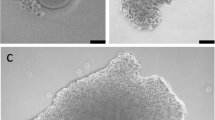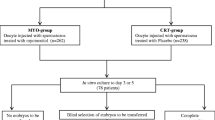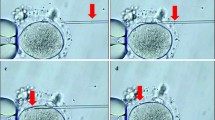Abstract
The effect of hyaluronidase removal of the cumulus oophorus on the in vitro fertilization rate of oocytes obtained from patients with poor oocyte fertilizability has been evaluated. Eighty-eight oocytes were obtained from 13 patients undergoing in vitro fertilization and embryo transfer (IVF-ET) for indications of male-factor, immunological, and idiopathic infertility. In addition, patients in whom fertilization did not occur on previous IVF cycles were evaluated in the study. The occytes of each individual patient were randomly assigned into a treatment (removal of the cumulus;N=40 oocytes) or nontreatment group (control;N=48 oocytes). Hyaluronidase was used to remove the cumulus immediately following oocyte retrieval, and insemination was performed 6–8 hr later. The overall oocyte fertilization rate (both treated and untreated) was 42%. The treatment group demonstrated a higher rate of fertilization compared to the nontreatment group (55% vs 31%;P<0.05). Examination of various patient groups revealed a statistically significant difference in fertilization rates between the treated and the untreated oocytes only in the “no previous fertilization” group (60% vs 28%;P<0.05). A higher rate of fertilization of the treated oocytes was also seen in the immunologic infertility group, however, statistical significance was not achieved (50% vs 25%;P=0.07). Only one clinical pregnancy was achieved in this group of 13 patients. We conclude that in this group of patients, removal of the cumulus prior to insemination may, in some cases, increase the fertilization potential of the oocyte.
Similar content being viewed by others
References
Mahadevan MM, Trounson AO, Leeton JF: The relationship of tubal blockage, infertility of unknown cause, suspected male infertility, and endometriosis to success of in-vitro fertilization and embryo transfer. Fertil Steril 1983;40:755
Mahadevan MM, Trounson AO: Removal of the cumulus oophorus from the human oocyte for in-vitro fertilization. Fertil Steril 1985;43:263
Laufer N, Tarlatzis BC, Naftolin F: In vitro fertilization State of the art. Semin Reprod Endocrinol 1984;2:197
Mahadevan MM, Trounson AO: The influence of seminal characteristics on the success rate of human in vitro fertilization. Fertil Steril 1984;42:400
Mahadevan MM, Leeton JF, Trounson AO, Wood C: Successful use of in vitro fertilization for patients with persisting low-quality semen.In In Vitro Fertilization and Embryo Transfer, M Seppala, RG Edwards (eds). Annals of the New York Academy of Sciences, 1985, Vol 442
Raulands IW: Role of hyaluronidase in fertilization. Nature 1942;150:627
Piko L: Gamete structure and sperm entry in mammals.In Fertilization, CB Metz, A Monroy (eds). New York, Academic Press, 1967, Vol 2, pp 325–405
Metz CB, Seiguer AC, Castro AE: Inhibition of cumulus dispertion and hyaluronidase activities of sperm by heterologous and isologous antisperm antibodies. Proc Soc Exp Biol Med 140:766, 1972
Joyce C, Freund M, Peterson RN: Contraceptive effects of intravaginal application of acrosin and hyaluronidase inhibitors in rabbits. Contraception 1979;19:95
Allison AC, Martee EF: Lysosomal enzymes in the acrosome and their possible role in fertilization. J Reprod Fertil 1970;21:501
Farooqui AA, Srivastavee DN: Isolation, characterization and the role of rabbit testicular arylsulfatase A in fertilization. Biochem J 1979;181:331
Dudkiewicz AB: Purification of boar acrosomal arylsulfatase. A and possible role in the penetration of cumulus cells. Biol Reprod 1984;30:1005
Author information
Authors and Affiliations
Rights and permissions
About this article
Cite this article
Lavy, G., Boyers, S.P. & DeCherney, A.H. Hyaluronidase removal of the cumulus oophorus increases in vitro fertilization. J Assist Reprod Genet 5, 257–260 (1988). https://doi.org/10.1007/BF01132173
Received:
Accepted:
Issue Date:
DOI: https://doi.org/10.1007/BF01132173




